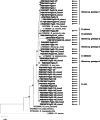Molecular identification and diversity of gastrointestinal apicomplexan protozoa in pigs in the Republic of Korea
- PMID: 40594808
- PMCID: PMC12216780
- DOI: 10.1038/s41598-025-08200-1
Molecular identification and diversity of gastrointestinal apicomplexan protozoa in pigs in the Republic of Korea
Abstract
The genera Cryptosporidium, Eimeria, and Cystoisospora cause gastrointestinal diseases in pigs that can lead to economic losses in the pig industry. Despite their importance, the molecular epidemiology and species diversity of these parasites remain poorly understood. Therefore, this study aimed to investigate the distribution and diversity of these genera Cryptosporidium, Eimeria, and Cystoisospora in pigs in Korea and to evaluate their potential influencing factors, including geographical location and season. A total of 700 fecal samples were collected from 103 pig farms between May 2020 and February 2023. PCR identified the genera Cryptosporidium, Eimeria, and Cystoisospora in 49 (7.0%), 24 (3.4%), and 6 (0.9%) samples, respectively. At the farm level, 43 (41.8%) out of 103 farms had at least one pig infected with these parasites. According to the region, Eimeria spp. showed the highest prevalence in Gyeongsangnam-do (8.5%; 17/200) with a statistically significant difference. Seasonal analysis revealed a statistically significant difference for Eimeria spp. with higher prevalence in summer (6.4%; 15/233) and winter (4.7%; 7/149). Phylogenetic analyses revealed Cryptosporidium (Cr.) scrofarum and Cr. suis, and confirmed the presence of Eimeria (E.) debliecki, E. perminuta, E. spinosa, and E. suis, as well as Eimeria sp. genotype 1-4. All Cystoisospora (Cy.) positive samples were confirmed as Cy. suis. This study examined the nationwide distribution of the genera Cryptosporidium, Eimeria, and Cystoisospora in pigs in Korea, providing molecular evidence of these parasites. The results improve our understanding of the distribution and diversity of apicomplexan protozoa in pigs in Korea. Notably, Cr. scrofarum and Cr. suis identified in this study are known to infect humans, indicating potential zoonotic risks. These findings highlight the importance of continued surveillance to mitigate economic losses on the pig industry and to address public health concerns.
Keywords: Cryptosporidium; Cystoisospora; Eimeria; Apicomplexan protozoa; Pig; Prevalence.
© 2025. The Author(s).
Conflict of interest statement
Declarations. Competing interest: The authors declare no competing interests. Ethical approval and consent to participate: Ethical review and approval were waived for this study, due to the study focused on post-slaughter samples.
Figures




Similar articles
-
Occurrence and Molecular Characterization of Cryptosporidium spp. in Swine Farms in Northeastern Spain.Pathogens. 2025 Jul 5;14(7):665. doi: 10.3390/pathogens14070665. Pathogens. 2025. PMID: 40732712 Free PMC article.
-
Prevalence and Genetic Diversity of Entamoeba and Cryptosporidium in Pigs and Wild Boars in Central and Southern Vietnam: Implications for Zoonotic Risks and Surveillance.Foodborne Pathog Dis. 2025 Aug;22(8):525-531. doi: 10.1089/fpd.2024.0095. Epub 2024 Oct 22. Foodborne Pathog Dis. 2025. PMID: 39435712
-
Molecular genetic characterization of Cryptosporidium and Cystoisospora protozoan infections in cats from large cities of Kazakhstan.Front Parasitol. 2025 Jul 14;4:1608542. doi: 10.3389/fpara.2025.1608542. eCollection 2025. Front Parasitol. 2025. PMID: 40727429 Free PMC article.
-
Systematic Review and Meta-Analysis of the Prevalence, Species Distribution and Risk Factors of Eimeria spp. in Iranian Livestock.Vet Med Sci. 2025 Jul;11(4):e70450. doi: 10.1002/vms3.70450. Vet Med Sci. 2025. PMID: 40509950 Review.
-
Cystoisospora suis - the non-model model coccidium.Adv Parasitol. 2025;127:1-25. doi: 10.1016/bs.apar.2025.03.001. Epub 2025 Apr 16. Adv Parasitol. 2025. PMID: 40588334 Review.
References
-
- Worliczek, H. L., Gerner, W., Joachim, A., Mundt, H. & Saalmüller, A. Porcine coccidiosis - Investigations on the cellular immune response against Isospora suis. Parasitol. Res.105, 151–156 (2009). - PubMed
-
- Matsubayashi, M. et al. Genetic identification of Entamoeba polecki subtype 3 from pigs in Japan and characterisation of its pathogenic role in ulcerative colitis. Infect. Genet. Evol.36, 8–14 (2015). - PubMed
MeSH terms
Grants and funding
LinkOut - more resources
Full Text Sources
Miscellaneous

